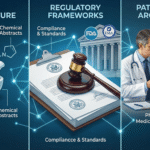Hematinics are agents that supply essential substrates for erythropoiesis—principally iron, vitamin B12, and folate—while iron chelators remove excess iron from overload states; together, these drugs correct deficiency anemias and mitigate transfusional siderosis when used with appropriate monitoring and route selection. This chapter details classification, mechanisms, pharmacokinetics, indications, dosing, adverse effects, interactions, and evidence-based cautions for hematinics and iron chelators for MBBS-level practice.
Core concepts
Hematinics correct impaired hemoglobin synthesis by replenishing missing cofactors (iron for heme, folate and cobalamin for DNA synthesis), thereby restoring effective erythropoiesis and normal red cell indices. Iron chelators (deferoxamine, deferasirox, deferiprone) bind labile ferric iron and facilitate excretion to prevent or reverse organ injury from transfusional iron overload. Hepcidin–ferroportin biology governs intestinal iron entry and macrophage iron release, shaping oral versus intravenous iron choices in inflammation and chronic disease.
Classification
- Hematinics: iron (oral and parenteral), vitamin B12 (cyanocobalamin, hydroxocobalamin), folic acid/folate (and folinic acid for rescue).
- Iron chelators: deferoxamine (parenteral), deferasirox (oral), deferiprone (oral).
Iron: physiology and mechanism
Dietary nonheme iron is reduced and transported across enterocytes by DMT1, stored in ferritin, and exported via ferroportin; transferrin carries Fe3+ to marrow for hemoglobin synthesis. Hepcidin from the liver binds ferroportin, triggering its degradation in duodenal enterocytes and macrophages, thereby suppressing dietary absorption and iron release from stores when iron is replete or inflammation is present. Oral or parenteral iron restores hemoglobin by repleting circulating iron and marrow iron supply; route choice hinges on tolerance, hepcidin status, urgency, and comorbid malabsorption.
Oral iron therapy
- Preparations and elemental iron: common salts include ferrous sulfate (~20% elemental iron), ferrous gluconate (~12%), and ferrous fumarate (~33%). A 325 mg ferrous sulfate tablet provides about 65 mg elemental iron, guiding total daily elemental doses and regimen choices.
- Administration: best absorbed on an empty stomach, separated from calcium, antacids, high-fiber foods, and tetracycline/quinolone antibiotics; ascorbic acid can modestly enhance absorption. Alternate-day or reduced-frequency dosing may improve GI tolerability and still replete iron when adherence is jeopardized, though comparative effectiveness varies across studies.
- Adverse effects: metallic taste, nausea, abdominal discomfort, constipation/diarrhea, dark stools, and dental staining with liquids; dose and salt selection influence tolerability and adherence.
- Overdose: dose-related toxicity presents with GI upset, metabolic acidosis, shock, and hepatic injury; management includes decontamination and chelation with deferoxamine for significant ingestion.
Parenteral iron therapy
- Indications: intolerance or nonresponse to oral iron, malabsorption, inflammatory states with high hepcidin, need for rapid repletion (late pregnancy, perioperative), and concurrent ESA therapy in CKD.
- Formulations: iron sucrose, ferric carboxymaltose (FCM), ferumoxytol, ferric derisomaltose, and low–molecular-weight iron dextran differ in dosing, infusion times, and specific risks.
- Hypophosphatemia: FGF23-mediated renal phosphate wasting is common after FCM, with severe hypophosphatemia reported far more often with FCM than with iron isomaltoside or iron sucrose. Prolonged cases exist and warrant phosphate monitoring and choice of alternative IV iron in at-risk patients.
- Other adverse effects: infusion reactions are uncommon across modern preparations, but hypersensitivity and hypertension can occur; iron dextran carries historical risk of anaphylaxis, mitigated with low–molecular-weight products.
Table: Oral iron salts and elemental iron
Optimizing oral iron
- Separate iron from antacids, calcium, and certain antibiotics to avoid chelation and reduced absorption; consider vitamin C coadministration for marginal gains if tolerated.
- Evaluate hepcidin drivers (inflammation, CKD) and gastrointestinal disorders when oral therapy fails to raise hemoglobin and ferritin as expected.
Vitamin B12 (cobalamin)
- Mechanism: cofactor for methionine synthase and methylmalonyl-CoA mutase, enabling DNA synthesis and neurologic integrity; deficiency causes megaloblastic anemia with possible neuropathy.
- Absorption and dosing: intrinsic factor–mediated ileal uptake is efficient, but even without intrinsic factor, high-dose oral therapy exploits passive absorption (~1.2%), enabling oral replacement in many cases.
- Parenteral regimens: typical IM schedules use 1 mg daily for a week, then weekly for a month, then monthly for maintenance; lifelong therapy for pernicious anemia is standard.
- Monitoring and cautions: reticulocyte rise occurs in 3–4 days, with hematologic recovery over weeks; never treat isolated macrocytosis with folate alone if B12 deficiency is possible to avoid worsening neuropathy.
Folic acid (vitamin B9) and folinic acid
- Folate in hematopoiesis: tetrahydrofolate cofactors are essential for thymidylate and purine synthesis, so deficiency causes megaloblastic anemia without the neurologic features of B12 deficiency.
- Causes and drugs: poor intake, alcoholism, pregnancy, hemolysis, and antifolate drugs (methotrexate, trimethoprim, phenytoin) precipitate deficiency and warrant targeted replacement.
- Dosing and prevention: oral folic acid corrects deficiency and is used prophylactically in pregnancy to reduce neural tube defects; always assess for concomitant B12 deficiency.
- Folinic acid (leucovorin): a reduced folate that bypasses dihydrofolate reductase, used to rescue from methotrexate toxicity and to potentiate 5-FU by stabilizing the ternary complex.
Iron chelators: mechanisms and selection
- Deferoxamine (DFO): a parenteral hexadentate chelator from Streptomyces that binds ferric iron with high affinity and promotes urinary and biliary excretion; used for acute iron poisoning and chronic transfusional overload. Adverse effects include infusion reactions, hypotension with rapid infusion, susceptibility to Yersinia infections, ocular/ototoxicity, and growth effects with long-term use.
- Deferasirox (DFX): an oral tridentate chelator forming a 2:1 complex with Fe3+, primarily fecally excreted; indicated in transfusional and non–transfusion-dependent overload with once-daily dosing. Boxed warnings include renal failure, hepatic failure, and GI bleeding, requiring regular creatinine, transaminases, and clinical monitoring.
- Deferiprone (DFP): an oral bidentate intracellular chelator that reduces liver iron and maintains or improves cardiac iron, particularly in thalassemia syndromes. Agranulocytosis risk mandates scheduled ANC monitoring, with intensified schedules during the first year and product-label–guided step-down thereafter; zinc depletion and transaminase elevations also warrant monitoring.
Table: Iron chelators compared
Special situations
- Inflammation/CKD: elevated hepcidin limits oral iron absorption, favoring IV iron to replete stores and synergize with erythropoiesis-stimulating agents.
- Pregnancy: iron needs rise; oral iron is first-line, and IV iron (e.g., iron sucrose or ferric derisomaltose) is considered when oral therapy fails or rapid repletion is needed, with attention to FCM hypophosphatemia.
- Perioperative/rapid repletion: IV iron corrects stores faster and improves preoperative hemoglobin in selected indications; choose preparations with lower hypophosphatemia risk when feasible.
Adverse effects and monitoring summary
- Oral iron: GI intolerance is dose-related; mitigate with dosing adjustments and avoidance of interacting foods/drugs; reassess cause of anemia if inadequate response.
- IV iron: monitor for hypersensitivity, blood pressure changes, and serum phosphate after FCM; select alternative IV iron in patients with risk factors for phosphate wasting.
- B12 and folate: monitor hematologic response and correct coexisting deficiencies; do not give folate alone if B12 deficiency is plausible to avoid neurologic harm.
- Chelators: tailor drug and dose to iron burden and organ involvement, with laboratory and symptom surveillance for known toxicities (renal/hepatic for DFX; ANC for DFP; visual/auditory for DFO).
Practical dosing pearls
- Oral iron: typical total daily elemental iron 60–120 mg in divided or reduced-frequency regimens based on tolerance, with repletion over weeks and continuation several months to refill stores.
- Deferoxamine: parenteral infusions titrated to iron burden and tolerance in chronic overload, and continuous IV in severe acute poisoning as clinically indicated.
- Deferasirox: once-daily dosing adjusted to ferritin/LIC and renal/hepatic labs, with prompt interruption for rising creatinine or transaminases or GI bleeding.
- Deferiprone: weight-based dosing in divided doses with label-directed ANC schedules (weekly for 6 months, then every 2 weeks for 6 months, then every 2–4 weeks if stable), plus periodic ALT and zinc.
Decision-making framework
- Confirm etiology of anemia (iron deficiency vs megaloblastic vs anemia of inflammation) and correct the specific deficit with route and formulation matched to absorption capacity, urgency, and tolerance.
- Use IV iron when hepcidin is high or malabsorption exists, and select products with lower hypophosphatemia risk if recurrent or severe phosphate wasting is a concern.
- Choose chelation based on iron burden, adherence, organ iron distribution, and safety profile, incorporating structured monitoring and patient education to mitigate serious adverse events.
Tables for quick review
Table: Hematinics and their primary roles
Table: IV iron and hypophosphatemia signal
I recommend testing yourself with a self-assessment quiz or test to reinforce your knowledge. This will allow you to practice and reinforce important aspects of these drugs without collecting any user data.
Please use desktops/laptops for a better experience of the quiz.
📚 AI Pharma Quiz Generator
🎉 Quiz Results
Medical Disclaimer
The medical information on this post is for general educational purposes only and is provided by Pharmacology Mentor. While we strive to keep content current and accurate, Pharmacology Mentor makes no representations or warranties, express or implied, regarding the completeness, accuracy, reliability, suitability, or availability of the post, the website, or any information, products, services, or related graphics for any purpose. This content is not a substitute for professional medical advice, diagnosis, or treatment; always seek the advice of your physician or other qualified health provider with any questions you may have regarding a medical condition and never disregard or delay seeking professional advice because of something you have read here. Reliance on any information provided is solely at your own risk.










